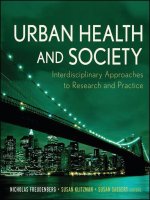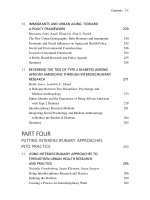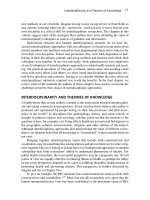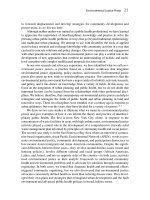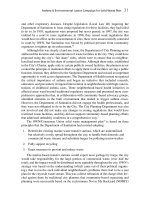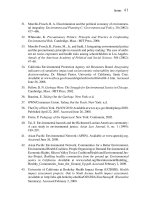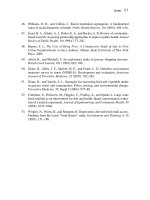Urban Health and Society: Interdisciplinary Approaches to Research and Practice - Part 24 pps
Bạn đang xem bản rút gọn của tài liệu. Xem và tải ngay bản đầy đủ của tài liệu tại đây (107.63 KB, 10 trang )
Discussion Questions 211
Allow a Longer Time Frame for Collaboration Assessment Two years are not a
large amount of time for a collaboration. More time is needed for members to under-
stand the research, contemplate how it could be implemented, implement a program,
and demonstrate an impact on public health. Collaboration members and funding
agencies may need to realize that ahead of time. Although traditional science may
norm ally take years to be translated into policy, transdisciplinary scientifi c collabora-
tion may take even longer because of the additional time needed to conduct the work.
Thus, it may take ten, fi fteen, or even twenty years to see effective translation occur.
This case study highlights some of the facets of transdisciplinary action research
that occurred among team members in a tobacco policy consortium. It is likely that the
lessons learned from this case study will inform future funding of research into the sci-
ence of team science. Guiding future scientists and professionals through the multiple
phases of team collaborations will improve as we understand more about the workings
of TD science, training, and translational initiatives.
In this chapter, we analyzed the Tobacco
Policy Consortium (TPC), a grant - funded
transdisciplinary action research consor-
tium of tobacco researchers and commu-
nity decision makers. The TPC collaborated
from 2003 through 2005, with the goals of
creating a grant program to support local
adolescent smoking prevention efforts and
developing and disseminating a research
and policy brief for local, state, and nati-
onal policymakers. Our assessments show
that despite initial differences in back-
grounds, work styles, and perspectives,
TPC researchers and community members
gradually came to share views on tobacco
control priorities as a result of repeated
brainstorming sessions and collective dis-
cussions. Although the TPC was success-
ful in accomplishing its major goals, it
fell short of achieving its full potential —
namely, to become self - sustaining and
reduce adolescent tobacco use. Lessons lear-
ned include improving future university -
community collaborations, enhancing the
“ science of team science, ” and incorporat-
ing measures for sustaining grant - funded
community - research partnerships from the
outset.
SUMMARY
DISCUSSION QUESTIONS
1. Why did the UC Irvine Tobacco Policy Consortium choose to use an interdisci-
plinary approach to understand youth tobacco use?
2.
What obstacles did the consortium encounter and how did they address them?
3. What steps could the consortium have taken to engage young people themselves
in their work? What might have been the advantages and disadvantages of
youth engagement?
c08.indd Sec6:211c08.indd Sec6:211 6/3/09 12:04:00 PM6/3/09 12:04:00 PM
212 Transdisciplinary Action Research on Teen Smoking Prevention
4. Based on their experiences, what suggestions do the authors make for improv-
ing the process and effectiveness of interdisciplinary action research? Do you
agree with their recommendations?
ACKNOWLEDGMENTS
The authors thank the Robert Wood Johnson Foundation for its support of the reported
research via RWJF grant number 46962. Without this support, this project would not have
been possible. We also thank all who participated as members of the UCI Tobacco Policy
Consortium. The work described in this chapter was supported by a grant from the National
Institutes of Health (NIDA/NCI) to establish the UCI TTURC (NIH award DA - 13332).
The authors are also grateful for the valuable contributions of Dr. Frances Leslie, Dr. Robin
Mermelstein, Dr. Kim Kobus, Dr. Glen Morgan, Kimari Phillips, and Amy Brewer to this
research.
NOTES
1. UC Irvine TTURC. Research and Policy Brief: Prevent Youth Smoking . Available
at www.tturc.uci.edu/UCI_TobaccoPolicyBrf_Aug05.pdf . Published 2005.
Retrieved August 1, 2007.
2. Stokols, D. Toward a science of transdisciplinary action research. American
Journal of Community Psychology, 38, no. 1 (2006): 63 – 77.
3. Lewin, K. Action research and minority problems. Journal of Social Issues, 2
(1946): 34 – 36.
4. Craik, K. H. Environmental psychology. Annual Review of Psychology, 24
(1973): 403 – 422.
5. Milgram, S. The experience of living in cities. Science, 167 (1970): 1461 – 1468.
6. Proshansky, H. M., Ittelson, W. H., and Rivlin, L. G., eds. Environmental
Psychology: People and Their Physical Settings, 2nd ed. New York: Holt,
Rinehart & Winston.
7. Butterfoss, F. D., Goodman, R. M., and Wandersman, A. Community coalitions
for prevention and health promotion: Factors predicting satisfaction, participa-
tion, and planning. Health Education Quarterly, 23, no. 1 (1996): 65 – 79.
8. Wandersman, A., Valois, R., Ochs, L., de la Cruz, D. S., Adkins, E., and Goodman,
R. M. Toward a social ecology of community coalitions. American Journal of
Health Promotion, 10, no. 4 (1996): 299 – 307.
9. Sommer, R. Action research. In D. Stokols, ed., Perspectives on Environment
and Behavior: Theory, Research, and Applications, pp. 195 – 203. New York:
Plenum Press, 1977.
c08.indd Sec6:212c08.indd Sec6:212 6/3/09 12:04:00 PM6/3/09 12:04:00 PM
Notes 213
10. Minkler, M., and Wallerstein, N., eds. Community - Based Participatory Research
for Health . San Francisco: Jossey - Bass, 2003.
11. Altman, D. G. Sustaining interventions in community systems: On the relationship
between researchers and communities. Health Psychology, 14 (1995): 526 – 536.
12. Conner, R. F., and Tanjasiri, S. P. Communities evaluating community - level
interventions: The development of community - based indicators in the Colorado
Healthy Communities Initiative. Canadian Journal of Program Evaluation, 14
(1999): 115 – 136.
13. Gray, B. Collaborating: Finding Common Ground for Multiparty Problems.
San Francisco: Jossey - Bass, 1989.
14. Klein, J. T. Crossing Boundaries: Knowledge, Disciplines, and Interdisciplinarities .
Charlottesville: University of Virginia Press, 1996.
15. Stokols, D., Misra, S., Hall, K., Taylor, B., and Moser, R. The ecology of team
science: Understanding contextual infl uences on transdisciplinary collaboration.
American Journal of Preventive Medicine, 35, no. 2S (2008): 96 – 115.
16. Esparza, J., and Yamada, T. The discovery value of “ big science. ” Journal of
Experimental Medicine, 204, no. 4 (2007): 701 – 704.
17. Maton, K. I., Perkins, D. D., Altman, D. G., Gutierrez, L., Kelly, J. G.,
Rappaport, J., et al. Community - based interdisciplinary research: Introduction to
the special issue . Available at www.springerlink.com/content/l053361v67386016 .
Retrieved October 10, 2006.
18. Nass, S. J., and Stillman, B. Large - scale Biomedical Science: Exploring Strategies
for Future Research . Washington, D.C.: National Academies Press, 2003.
19. Stokols, D., Hall, K. L., Taylor, B., and Moser, R. P. National Cancer Institute
Conference on the Science of Team Science: Assessing the value of transdisci-
plinary research, October 30 – 31, 2006. Available at />Summary.asp?File=13474 , ,
, and http://
dccps.nci.nih.gov/brp/scienceteam/presentations_day2.html . Published 2006.
Retrieved August 8, 2007.
20. Wuchty, S., Jones, B. F., and Uzzi, B. The increasing dominance of teams in pro-
duction of knowledge. Science Express, 316, no. 5827 (2007): 1036 – 1039.
21. National Cancer Institute. Centers for Population Health and Health Disparities.
Available at . Published
2006. Retrieved September 10, 2006.
22. National Cancer Institute. Health communication and informatics research:
NCI Centers of Excellence in Cancer Communications Research . Available at
c08.indd Sec7:213c08.indd Sec7:213 6/3/09 12:04:00 PM6/3/09 12:04:00 PM
214 Transdisciplinary Action Research on Teen Smoking Prevention
. Published 2006. Retrieved October
5, 2006.
23. National Cancer Institute. Transdisciplinary Research on Energetics and Cancer
Centers . Available at www.compass.fhcrc.org/trec . Published 2006. Retrieved
September 15, 2006.
24. National Cancer Institute. Transdisciplinary Tobacco Use Research Centers.
Available at . Published 2006. Retrieved
October 1, 2006.
25. National Center for Research Resources. Clinical and translational science
awards to transform clinical research. Available at www.ncrr.nih.gov/ncrrprog/
roadmap/CTSA_9 - 2006.asp . Published 2006. Retrieved on October 11, 2006.
26. National Academy of Sciences. The NAS/Keck initiative to transform interdisci-
plinary research. Available at www.keckfutures.org . Published 2003. Retrieved
July 18, 2003.
27. Robert Wood Johnson Foundation. Active living research. Available at www
.activelivingresearch.org/about . Published 2006. Retrieved February 13, 2009.
28. Jessor, R. The problem of reductionism in psychology. Psychological Review, 65
(1958): 170 – 178.
29. Stokols, D. Conceptual strategies of environmental psychology. In D. Stokols
and I. Altman, eds., Handbook of Environmental Psychology, pp. 41 – 70.
New York: John Wiley, 1987.
30. Campbell, D. T., and Fiske, D. W. Convergent and discriminant validation by the
multitrait - multimethod matrix. Psychological Bulletin, 56, no. 2 (1959): 81 – 105.
31. Winett, R. A., King, A. C., and Altman, D. G. Health Psychology and Public
Health: An Integrative Approach . New York: Pergamon Press, 1989.
32. Stokols, D. The future of interdisciplinarity in the School of Social Ecology.
Available at www.drugabuse.gov/ttuc/Readings.html . Published 1998. Retrieved
March 25, 2005.
33. Fuqua, J. Transdisciplinary scientifi c collaboration: An exploration of the
research process. Doctoral dissertation (2002). School of Social Ecology,
University of California, Irvine.
34. Hildebrand - Zanki, S., Cohen, L., Perkins, K., Prager, D. J., Stokols, D., and
Turkkan, J. Barriers to Transdisciplinary Research in Youth Tobacco Use
Prevention. A Report from the Working Group to the Youth Tobacco Use Prevention
Initiative. Washington, D.C.: Center for the Advancement of Health and the Robert
Wood Johnson Foundation, 1998.
c08.indd Sec7:214c08.indd Sec7:214 6/3/09 12:04:01 PM6/3/09 12:04:01 PM
Notes 215
35. Rhoten, D., and Parker, A. Risks and rewards of an interdisciplinary research
path. Science, 306 (2004): 2046.
36. Stokols, D., Fuqua, J., Gress, J., Harvey, R., Phillips, K., Baezconde - Garbanati, L.,
et al. Evaluating transdisciplinary science. Nicotine Tobacco Research, 5, Suppl
1 (2003): S21 – 39.
37. Stokols, D., Harvey, R., Gress, J., Fuqua, J., and Phillips, K. In vivo studies of
transdisciplinary scientifi c collaboration: Lessons learned and implications for
active living research. American Journal of Preventive Medicine, 28, no. 2S2
(2005): 202 – 213.
38. Shortliffe, E. H., Patel, V .L., Cimino, J. J., Barnett, G. O., and Greenes, R. A. A
study of collaboration among medical informatics research laboratories. Artifi cial
Intelligence in Medicine, 12(1998): 97 – 123.
39. Tuckman, B. W. Developmental sequence in small groups. Psychology Bulletin,
63, no. 6 (1965): 384 – 399.
40. Rosenberg, M. Cognitive structure and attitudinal affect. Journal of Abnormal
and Social Psychology, 53 (1956): 367 – 372.
41. Abrams, D. B. Applying transdisciplinary research strategies to understanding
and eliminating health disparities. Health Education and Behavior, 33, no. 4
(2006): 515 – 531.
42. Morgan, G., Kobus, K., Gerlach, K. K., Neighbors, C., Lerman, C., Abrams, D. B.,
et al. Facilitating transdisciplinary research: The experience of the transdisci-
plinary tobacco use research centers. Nicotine & Tobacco Research, 5, Suppl 1
(2003): S11 – S19.
43. Lesser, E. L. Leveraging social capital in organizations. In E. L. Lesser, ed.,
Knowledge and Social Capital: Foundations and Applications, pp. 3 – 16. Boston:
Butterworth - Heinemann, 2000.
44. Hall, K., Feng, A., Moser, R., Stokols, D., and Taylor, B. Moving the science of
team science forward: Collaboration and creativity. American Journal of Preventive
Medicine, 35, no. 2S (2008): 243 – 249.
45. Florin, P., and Wandersman, A. An introduction to citizen participation, voluntary
organizations, and community development: Insights for empowerment through
research. American Journal of Community Psychology, 18 (1990): 41 – 54.
46. Gray, B. Conditions facilitating interorganizational collaboration. Human
Relations, 38 (1985): 911 – 936.
47. Schermerhorn, J. J. Determinants of interorganizational cooperation. Academy of
Management Journal, 18 (1975): 846 – 856.
c08.indd Sec7:215c08.indd Sec7:215 6/3/09 12:04:01 PM6/3/09 12:04:01 PM
216 Transdisciplinary Action Research on Teen Smoking Prevention
48. Hall, K., Stokols, D., Moser, R., Taylor, B., Thornquist, M., Nebeling, L., et al.
The collaboration readiness of transdisciplinary research teams and centers:
Findings from the National Cancer Institute TREC baseline evaluation study.
American Journal of Preventive Medicine, 35, no. 2S (2008): 161 – 172.
49. Buehler, R., Griffi n, D., and Ross, M. Exploring the “ Planning Fallacy ” : why
people underestimate their task completion times. Journal of Personality and
Social Psychology, 67 (1994): 366 – 381.
50. Kerner, J., Rimer, B., and Emmons, K. Introduction to the special section on dis-
semination: Dissemination research and research dissemination: How can we
close the gap? Health Psychology, 24, no. 5 (2005): 443 – 446.
51. National Cancer Institute. NCI - NIH Conference on the Science of Team Science:
Assessing the Value of Transdisciplinary Research . Available at http://videocast.
nih.gov/Summary.asp?File=13474 and asp?
File=13471 . Published 2006. Retrieved February 17, 2008.
c08.indd Sec7:216c08.indd Sec7:216 6/3/09 12:04:01 PM6/3/09 12:04:01 PM
CHAPTER
9
HOW VULNERABILITIES
AND CAPACITIES SHAPE
POPULATION HEALTH
AFTER DISASTERS
CRAIG HADLEY, SASHA RUDENSTINE, SANDRO GALEA
LEARNING OBJECTIVES
■ Describe some of the ways that natural and human disasters affect the health
of urban populations.
■ Identify antecedent social, political, and environmental factors that can infl uence
how a population responds to a disaster.
■ Discuss the value and limits of epidemiological and anthropological insights into
the consequences of disasters.
■ Compare and contrast the health and social impact of Hurricane Katrina and
the September 11 attack on the World Trade Center.
c09.indd 217c09.indd 217 6/3/09 12:04:49 PM6/3/09 12:04:49 PM
218 Population Health After Disasters
Several recent high - profi le natural disasters (e.g., the southeast Asian tsunami of
2004 and the Gulf Coast hurricanes in the United States of 2005) and terrorist events
(e.g., the September 11, 2001, terrorist attacks and the March 11, 2004, Madrid train
bombings) have heightened awareness of disasters as important determinants of popu-
lation health and have resulted in a concomitant increased interest in the consequences
of disasters. Although the sporadic nature of lay and scientifi c reporting about high -
profi le disasters may suggest that these events are episodic and rare, general surveys of
the U.S. population suggest that individual exposure to disasters is quite high and that
approximately 10 percent of the U.S. population will experience a disaster during their
lifetime.
1
,
2
Comparable international data suggest that since the mid - 1980s, hundreds
of millions of individuals worldwide have been affected by disasters, be it in the
form of terrorism, famine, forced relocation, or political violence.
3
These fi gures sug-
gest that although defi nitions of disasters and the approaches used to study them may
be quite disparate,
4
,
5
disasters have been and remain a relatively common piece of the
human experience.
6
Despite the mental and physical health burden that disasters exact,
7
academic and public health interest in disasters remains episodic at best and in many
cases falls along disciplinary lines. Public health perspectives on disasters have typi-
cally centered on a medical model of disaster preparedness and generally less on the
broader issues of why some populations appear to suffer greater health consequences
of disasters than others.
Our objectives for this chapter are largely theoretical and conceptual. We suggest
that greater attention to the social - ecological determinants of the postdisaster context
may prove useful in understanding why some populations suffer more than others and
that such an approach reveals unique insights for prevention and intervention. We also
suggest that data collection and analysis methods that combine qualitative and quanti-
tative methods and are informed by different disciplinary perspectives are critical in
identifying factors that promote or undermine health in the postdisaster setting. We
then outline a conceptual model that is useful for understanding the underlying deter-
minants of population health in the postdisaster setting. The model calls attention to
the underlying vulnerabilities and capacities that infl uence health and well - being,
which we illustrate by drawing examples from the disaster literature and through three
case studies. We conclude by examining the unique impact of disasters on the world ’ s
growing urban population.
SOCIAL AND ECONOMIC DETERMINANTS
OF HEALTH AFTER DISASTERS
Socioecological perspectives on the determinants of population health suggest that
factors at multiple levels of infl uence contribute to individual and population health.
8
These may include macrolevel historical and political factors, mesolevel factors such
as social networks, and microlevel factors such as race/ethnicity.
9
,
10
Within this para-
digm, it has been suggested that the determinants of population health may usefully be
conceptualized as either vulnerabilities (e.g., poor aggregate socioeconomic status) or
c09.indd 218c09.indd 218 6/3/09 12:04:49 PM6/3/09 12:04:49 PM
Social and Economic Determinants of Health After Disasters 219
capacities (e.g., natural resources) and that population health refl ects the interplay
between underlying vulnerabilities and capacities and intermittent stressors (e.g.,
disasters) and protective factors (e.g., delivery of aid or other material resources).
11
We suggest that social determinants at multiple levels of infl uence are also likely to
infl uence health and well - being in the postdisaster context. This is a position close
to that taken by geographers and anthropologists to explain why disasters occur;
indeed, Hoffman and Oliver - Smith
4
explicitly defi ne a disaster as “ a process leading to
an event that involves a combination of a potentially destructive agent from the natural
or technological sphere and a population in a socially produced condition of vulner-
ability. ” Consistent with this approach and seemingly developed in parallel, public
health practitioners have also identifi ed a range of social - ecological factors that predict
the severity of impact on health and well - being across disaster settings. This consili-
ence of approaches is exemplifi ed by the work of Blaikie et al.
12
whose comprehensive
model of the factors leading to disaster builds off the work of Hewitt.
13
Briefl y, Blaikie
et al. ’ s model calls attention to multiple layers of infl uence, including history, class,
resources, power, as well as aspects of the built environment and the interaction of
these factors with a hazard. Hazards, or the physical agent of the disaster (e.g., fl ood,
fi re, etc.), are but one part of the equation producing disasters. Disasters are produced
when a hazard intersects with existing vulnerabilities, which as stated earlier, are gen-
erated through a range of factors. This model can be usefully extended to include the
health and well - being of populations in the postdisaster setting.
The social - ecological model can also be usefully extended to include not just vulnera-
bilities but also capacities, which are protective social and ecological features. Such a
framework may be useful in the postdisaster context. This view encourages the researcher
to identify underlying population - level factors that act as constants in promoting or erod-
ing health and well - being in the pre - and postdisaster setting. A wide range of factors may
be considered as underlying vulnerabilities, such as the paucity of material resources (e.g.,
low income) available to a given human population or the presence of a natural tectonic
fault line that predisposes a population to earthquakes. Conversely, examples of underly-
ing capacities may include social capital, abundant availability of natural resources, high
levels of contributions to public goods, or a dispersed and effective informal safety net.
However, the intermittent stressors that interact with existing vulnerabilities and capacities
include the closure of a large employer or a hazard; these are inevitable events whose
occurrence is neither frequent nor predictable. Protective events, such as the opening of a
new school or an increase in group cohesiveness due to the success of a local sports team,
also occur intermittently. Importantly, these intermittent infl uences, which interact with
the underlying conditions, shape health at any particular moment in ways that are not nec-
essarily amenable to standard epidemiological analyses.
Although this perspective is relatively new in our thinking about the consequences
of disasters, the suggestion that we can understand population health as the outcome of
trade - offs between population vulnerabilities and capacities is not novel. Nor is the idea
that understanding the social and ecological conditions of the affected imperative to
c09.indd 219c09.indd 219 6/3/09 12:04:49 PM6/3/09 12:04:49 PM
220 Population Health After Disasters
understanding how and why populations vary in their capacities and vulnerabilities.
Diverse academic disciplines have long considered the factors that determine or covary
with vulnerability.
14
,
15
Still others have postulated that vulnerability can include genetic
and biological vulnerability at the individual level
16
and social vulnerability at the
group level.
17
In the study of disaster preparedness, it has long been recognized that
certain populations are also more vulnerable to the effects of disasters than others,
18
and detailed case studies, often carried out by anthropologists,
4
have shown that multi-
ple layers of history, ecology, and culture overlap to produce and augment existing
group - level vulnerability.
Virchow, a physician - anthropologist, reports in his mid - nineteenth century writings
an ethnomedical description of several Bavarian villages in which he makes precisely
the same distinction between population - level vulnerabilities and capacities. He uses
extensive ethnographic observation to understand population - level variability in these
two factors. For instance, after a lengthy ethnographic account of the settlement and
living conditions in several villages, he notes “ the untoward conditions of social life in
[these villages] are offset to a great extent by the benefi cial infl uence of the elevation
of the land and the formation of the soil, and that [as a result] this poverty - stricken . . .
population, which faces death by starvation every single year of crop failure, shows a
mortality rate almost as low as that prevailing in the best countries of the old world. ”
19
A high level of poverty, which acts as a population - level vulnerability, is countered by
the ecological positioning of the area, a capacity that accounts for the low levels of
mortality. Clearly, in many cases, vulnerabilities and capacities do not necessarily rep-
resent separate dimensions but rather ends of a spectrum, and in most cases, the lack of
a specifi c capacity may represent a specifi c population - level vulnerability.
Although the full range of vulnerabilities and capacities that may infl uence popula-
tion health after disasters is broad and locally specifi c, we have elsewhere made an
attempt to delineate some of the general elements that might infl uence postdisaster con-
sequences.
20
These elements include geography and history, demographic and poli tical
structures, community wealth and asset holdings, and aspects of the built environment
and formal and informal social environments.
As underlying factors, geography and history contribute to outcomes of disasters in
several ways. First and most obviously, some areas are naturally more at risk than are
others. In these areas, the risk of recurrent disasters is virtually unavoidable, and the exi-
gencies of geography then highlight the fact that there is likely no solution for the total
elimination of these disasters. Geography also plays an important role in structuring the
postdisaster response. News of a disaster event in isolated communities may take far
longer to reach aid agencies or the media (as in the case of the Darfur famine of 2004 –
2005) than it might after disasters in more readily accessible locations. Similarly, the
ability of agencies to provide aid may well be limited in geographically distant or diffi -
cult locales. For example, it took more than a week for domestic and international aid
efforts to reach some victims of the devastating 2005 earthquakes in the Kashmir region
that killed an estimated 80,000 people.
21
c09.indd 220c09.indd 220 6/3/09 12:04:50 PM6/3/09 12:04:50 PM

